
Carol Klein welcomes us to Life in a Cottage Garden at her home Glebe Cottage, Chittlehamholt near Umberleigh Devon, 15 miles from the coast.
For over 30 years Carol has looked after the garden which is loved not only by herself but her family too and she knows every part of the soil and the plants.
She loves spending time in the garden and enjoying the peace of the surrounding countryside.
Every season brings delight, challenges and problems 'but that's the thing about gardening, it's ever-changing and its's always exhilarating.
Over the 6 episodes Carol is going to show a whole year in the garden 'how it grows, flourishes, dies and is reborn.
It is November and December in the garden and it is when it goes through the most dramatic changes from the Sepia of late Autumn to the bare bones of Winter.

In these months you realise how powerful nature is as the colour slides away from the garden, everywhere is bare and as the temperatures plummet but there are still lots to do in the garden.
The garden has to be put to bed for the Winter and its the last chance to plant bulbs.

Carol is mixing some compost to load into the wheelbarrow for potting her Tulips up and she doesn't like to use straightforward multi-purpose compost so she makes her own mix to give them a good start.
She mixes equal parts of multi-purpose and sterilised loam, with plenty of grit added for drainage and as they are alkaline loving she adds lime.
She is very excited to start potting them up and Carol has thousands of them to do!

She has ordered them weeks ago and then there is the wait for them to arrive followed by the rush to get them planted and each bulb is a perfect little sculpture says Carol.
She cannot grow tulips in her heavy wet, clay soil as they need light well drained soil and baking sun, so she uses large terracotta pots.
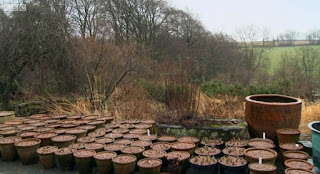
Carol packs the bulbs into the pot, something you cant do in the soil as they would rot but due to the light gritty soil in the pots they do well like this.
They sit out on the Top Terrace all Winter as they need a period of cold weather to flower properly then in the Spring when they start emerging she will move them round the garden.

Carol says November is a 'tragic' month but she still loves it and the feeling that there is nothing you can do about everything changing as part of the cycle of the garden.
All the colour in the garden starts to fade and then the Evergreens shine through like Carol's cloud pruned Box hedge and her conifers and the last splashes of red leaves on the Acers.
On the dark nights Carol is in her potting shed thinking back to July when it was sunny and she marked out the special Eryngium Bourgatii flowers she wanted to collect the seeds from.
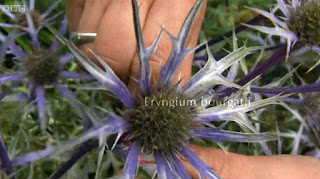
She had two different colours, one was brilliant blue and the other purple and she collected the seed heads in the Autumn.
They have been hanging up in the shed in their paper bags and now she is cleaning the seed heads and pushing out the seeds with a chopstick.
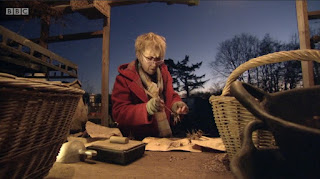
She then blows off the chaff, leaving just the seeds before sowing them on the surface of compost in half seed trays.
Carol then covers them in her usual layer of grit and the trays go out into the cold as they belong to the Apiaceae family so they like a cold spell.
She also says as there is a waxing new moon it is the perfect night for doing it!
Time to prune the Cotinus 'Grace' Smoke Bush again as it has suffered due to the high winds they have had so the damaged branches need removing.

There are two sorts of leaves on it at the moment, live and dead ones, as the branches have been broken and are brittle.
You can see where it has torn away from the main trunk and Carol gets out her pruning saw to neaten up the cut, there is a huge pile of removed branches.
Carol has got a cuppa out in the garden and everywhere the trees and plants are dying down and going to sleep for the Winter.

There is a feeling of sadness and dankness in the garden and everywhere is damp but still there is beauty within the garden.
The Magnolia has just lost the last of its amber leaves and you can see the furry grey buds of next years flowers hidden amongst the Lichen clad branches.
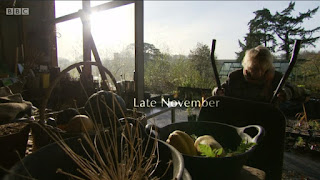
It is late November and Carol is off with her wheelbarrow to see her Hedychiums that were hit hard by an early October frost, that really need taking inside as they are a bit tender. They would survive if planted in the border, but these ones are in pots.
Dahlias also now the tops are totally dead they need moving and she is going to tuck everything in until Spring when they come back to life.
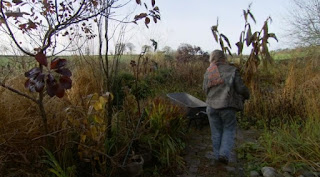
There is a Poppy trying to start growing through the earth but Carol has a lot of pots to collect and move, thank goodness its a beautiful day in the garden.
Wheelbarrow now full, she starts the energetic job of moving them all, and it is just what she needs to keep warm, as its rather cold.
She reaches the cosy greenhouse, which is to be there winter home for all the tender and semi-tender plants.
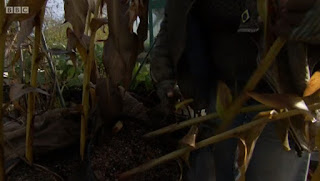
She chops the stems right to the base of the Hedychiums, if the stems were still green she would leave them to die down.
She puts them in the greenhouse alongside her Bananas and Eucomis and then everything in the greenhouse will remain dormant.
Some people remove the tubers from the pots but she likes leaving them in them and in the Spring will start watering and feeding them.
Carol is in the Hot Border and it the end for the Ricinus which are a tender plant she grew from seed earlier in the year but unlike Gingers and Dahlias they have no Tubers to carry them over the Winter.
She treats them as annuals and they are pulled up and added to the compost pile.

December and plants are dying or going to sleep but its still a lovely time of year to enjoy your surroundings and Carol is off for a walk with her dogs.

The Devonshire countryside is a place Carol loves to get out into in December as she is in the garden all the time she really appreciates where she lives when she does.
The landscape is showing its bare bones, with the skeleton trees, and bare hedges.
There is a beautiful Holly Tree and it was covered in berries, but now it has turned colder the Redwings have stripped it but there are still berries all over the ground.

Carol wants some Holly for her native hedge so she has picked up a load of the stray berries.
Back at the potting shed she is planning to fool the berries into thinking they have been through a winter by putting them in a plastic bag with some sifted leaf mould and then putting them in the fridge.
In a couple of weeks she will bring them out and sow them in some trays with some soil and they will germinate in a few weeks and she will have her own holly trees.
Holly is such an important plant along with Ivy as she continues her walk pointing out an Oak tree laden with Ivy.
Ivy is a magical plant and when trailing on the floor it never flowers and provides great cover for mammals and birds.
When it is climbing it is at its best as it then has flowers full of nectar in the Autumn into Winter where they change into black coloured berries.
Ivy is so important for wildlife and Carol is always planting it in her garden.
December although it is dark, dank and dreary underneath that there is life waiting to burst through with Snowdrops and her Mum's Christmas Rose already appearing.
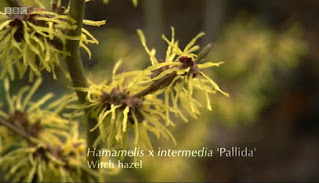
It is pouring and Carol is out with her wheelbarrow again and she is planting a beautiful Hamamelis x Intermedia Pallida, her favourite Witch Hazel.
It has beautiful spidery flowers and it is a replacement for one that just died for no reason.
She plants it level with the surrounding soil and adds some compost to it, and it will not need watering.
Leaf Bud Cuttings
On a cold December day the garden has a strange quiet about it so Carol is back in her potting shed in the dark.
The days are short, it seems like you just get up and its then time to go inside.

There are still things she can be doing at this time of year including some plants that are best propagated now.
Anything belonging to the Mahonia or Berberis family are best done at this time of year from a leaf bud cutting and Carol has a Mahonia Japonica cutting to do.
You need to cut off a nice chunky piece and then to cut above the bud with secateurs and your left with a long bit of stem with leaves on.
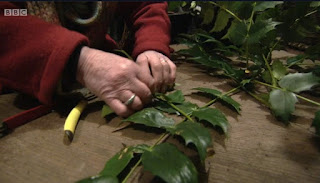
Carol then rolls the leaf end up which is very odd as some people just chop the leaf in half!
She likes the cutting to receive moisture from the leaves she secures it with a rubber band.
She she pots it singularly in a terracotta pot filled with gritty compost so the top of the cut is flush with the top of the compost.
She then firms it and adds grit before putting it on the heated bench in the greenhouse.

Late December and it is raining and she is in Annie's garden where in the Autumn, Annie came to visit and although she has always loved the tree it now has very bad Canker and to Carol's amazement, she said maybe its now the time for it to go.
Carol then realised she is actually very fond of the tree too and Canker is a fungal disease and effects the wood leaving it lumpy and distorted.
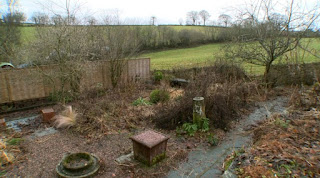
It has not stopped it flowering or fruiting but it does weaken the tree.
The only way to truely get rid of Canker is to cut the tree down but now Carol is saying she not prepared to do that!
Annie's Garden has had a major revamp this year where they took all the plants out, divided, put back and new plants added all through the year.

Carol been happy with how the garden has been going and it is a continual work in progress.
The Hot Border has been amazing this year as a lot of the plants are tender but it all came out and looked like a jungle of colour.
Alice's Garden has not had a lot done to it other than weeding and staking but in the Summer it looked glorious with the perfect weather.
The Brick Garden looks after itself too and it is also called the yellow and blue garden, due to the flowers that are packed into it.

In September there are masses of yellow that takes over so this is where she is going to add the Eryngiums she grew from her collected seeds to balance the colours more.
She is also going to add Pulmonaria Blue Ensign that she divided back in the spring and both plants will attract lots more insects into the garden.
When Carol started her garden more than 30 years ago when they came to the cottage she says;
'I really thought that, somehow I was going to be in control. But really, although I adjust and manage here and there, the point is about gardening, and about my garden in particular, is that the garden tells you what it wants to do. It tells you what it wants to be.'

'I just love it'!
All photographs are copyright of BBC.com

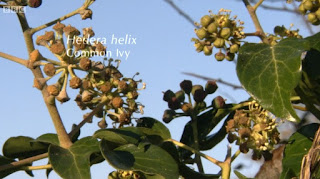
No comments:
Post a Comment